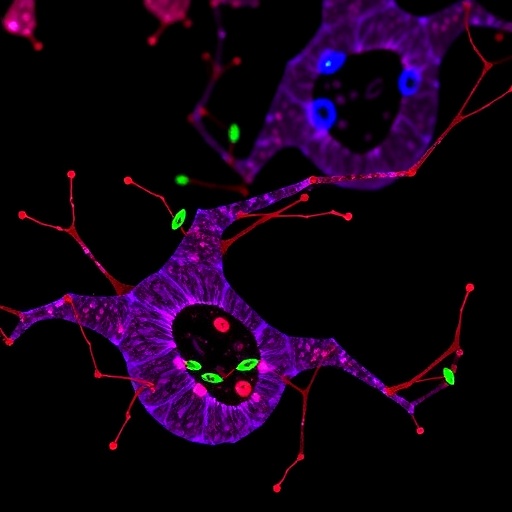Aging remains one of the most formidable challenges in medicine, not just because of its ubiquity but due to the cascade of degenerative diseases it triggers, chief among them being osteoarthritis. This debilitating joint disorder predominantly affects the elderly, wreaking havoc on the cartilage and leading to chronic pain and impaired mobility. Central to the pathological landscape of osteoarthritis is the inflammatory cytokine tumor necrosis factor-alpha (TNF-α), whose heightened expression fuels joint inflammation and cartilage degradation. Recent cutting-edge research has shed light on a novel molecular player, TNF alpha-induced protein 8 like 2 (TIPE2), revealing its potential as a critical regulator of TNF-α and cellular senescence within osteoarthritic joints. This fresh perspective not only deepens our molecular understanding but also points toward promising therapeutic avenues.
The degenerative process of osteoarthritis involves a complex interplay between mechanical stress, inflammatory mediators, and cellular aging phenomena collectively termed cellular senescence. Senescent cells enter a state of permanent growth arrest but remain metabolically active, secreting a harmful mélange of pro-inflammatory factors known as the senescence-associated secretory phenotype (SASP). TNF-α stands out among these factors, as it perpetuates inflammatory cycles and accelerates extracellular matrix breakdown within cartilage tissue. Thus, the control of TNF-α dynamics emerges as a pivotal intervention point in mitigating osteoarthritis progression.
Notably, conventional approaches targeting TNF-α with monoclonal antibodies have achieved only partial success. These therapies, while effective in dampening systemic inflammation, often fall short of completely inhibiting TNF-α activity within joint microenvironments and require repeated administration. This shortcoming underscores the pressing need for alternative strategies that can more precisely and sustainably modulate TNF-α levels without eliciting systemic immune suppression or adverse effects. Here, TIPE2 has attracted attention due to its innate aptitude for negative regulation of immune and inflammatory responses.
.adsslot_FrNR5spHqI{ width:728px !important; height:90px !important; }
@media (max-width:1199px) { .adsslot_FrNR5spHqI{ width:468px !important; height:60px !important; } }
@media (max-width:767px) { .adsslot_FrNR5spHqI{ width:320px !important; height:50px !important; } }
ADVERTISEMENT
TIPE2 is recognized as an intrinsic immune modulator capable of restraining excessive inflammatory activation in both innate and adaptive immunity. Previous investigations have hinted at its involvement in various inflammatory diseases, but its role in age-related osteoarthritis remained largely unexplored until recent animal model studies provided critical insights. Utilizing the Zmpste24 knockout mouse, an accelerated aging model that recapitulates senescence-driven joint degeneration, researchers achieved adenoviral-mediated overexpression of the TIPE2 gene, unveiling its therapeutic promise.
The experimental augmentation of TIPE2 in these aged mice’s articular cartilage led to notable improvements in histological markers. Specifically, enhanced safranin O staining—a reflection of glycosaminoglycan abundance and cartilage matrix integrity—was observed, indicating cartilage preservation. This histochemical improvement aligns with a concomitant reduction in hallmark senescence markers such as β-galactosidase activity and CDKN2A/p16 expression in chondrocytes, the specialized cells maintaining cartilage homeostasis. These findings illustrate TIPE2’s capacity to suppress cellular senescence and preserve chondrocyte functionality.
At a mechanistic level, TIPE2 transfection was demonstrated to significantly attenuate TNF-α secretion from chondrocytes. Given TNF-α’s central role in initiating and sustaining cartilage inflammation, this downregulation disrupts the vicious cycle of inflammation and senescence-associated tissue deterioration. By lowering TNF-α levels, TIPE2 intervention mitigates the SASP cascade, reducing pro-inflammatory milieu and potentially slowing disease progression. These phenomena collectively support the conceptualization of TIPE2 as a molecular brake that can temper inflammatory senescence in aging joints.
Despite the compelling in vivo evidence, the precise molecular pathways mediating TIPE2’s regulation of TNF-α expression and secretion remain elusive. A deeper mechanistic understanding requires detailed interrogation of intracellular signaling intermediates, transcriptional regulators, and protein-protein interactions influenced by TIPE2. Furthermore, the intricate linkage between chondrocyte senescence and osteoarthritis pathogenesis warrants further exploration to delineate causation versus correlation within disease progression, which could unearth novel molecular targets.
The therapeutic implications of TIPE2 activation extend beyond mere TNF-α modulation. By influencing cellular senescence markers and potentially altering the SASP profile, TIPE2 emerges as a promising senomorphic agent—compounds that remodel or suppress pathogenic features of senescent cells without eliminating them. Such senomorphics could offer a refined approach in managing age-related diseases, addressing inflammation and tissue degeneration in a therapeutically manageable manner.
Nonetheless, these promising findings currently rest on preclinical foundations. Robust clinical investigations are essential to evaluate the safety, efficacy, and optimal delivery methods of TIPE2-based therapeutics in human populations afflicted with osteoarthritis. Such clinical trials will need to consider disease heterogeneity, stages of progression, and potential off-target effects to translate laboratory success into patient benefit.
Moreover, the development of TIPE2 as a treatment modality necessitates comprehensive molecular research to identify any potential compensatory mechanisms within the immune network that might attenuate its effects or create unintended immunological consequences. Insight into these dynamics will be critical for designing combination therapies or engineered molecules with greater specificity and potency.
Beyond osteoarthritis, understanding TIPE2’s role in cellular senescence and inflammation could have ramifications for numerous age-associated diseases characterized by chronic inflammation, including neurodegeneration, cardiovascular diseases, and metabolic syndromes. The cross-disciplinary relevance emphasizes the transformative potential of TIPE2 research as a keystone in age-related biomedical science.
In addition to molecular biology, integrating systems biology approaches could illuminate network-wide effects of TIPE2 modulation. High-throughput omics technologies—transcriptomics, proteomics, and metabolomics—could map comprehensive pathways influenced by TIPE2, revealing hitherto unknown biomarkers or regulatory feedback loops crucial in osteoarthritis and aging in general.
Ultimately, the convergence of molecular insights and innovative biotechnologies heralds a new chapter in combating osteoarthritis and other senescence-linked maladies. TIPE2’s emergence from obscure immunoregulation to a focal candidate in joint health epitomizes the rapid scientific advances in understanding the molecular underpinnings of aging diseases.
In conclusion, the discovery of TIPE2’s role in modulating TNF-α expression and cellular senescence within osteoarthritic cartilage represents a significant breakthrough. This research trajectory holds immense promise for developing innovative, senescence-targeted therapies that could transform clinical management of osteoarthritis, thereby improving quality of life for millions facing age-related joint degeneration worldwide.
Subject of Research: Cellular senescence, TNF-α regulation, and osteoarthritis pathogenesis in aging
Article Title: Hallmarks and mechanisms of cellular senescence in aging and disease
Article References:
Ajoolabady, A., Pratico, D., Bahijri, S. et al. Hallmarks and mechanisms of cellular senescence in aging and disease. Cell Death Discov. 11, 364 (2025). https://doi.org/10.1038/s41420-025-02655-x
Image Credits: AI Generated
DOI: https://doi.org/10.1038/s41420-025-02655-x
Tags: aging-related joint disorderscartilage degradation processescellular senescence and agingchronic pain and mobility impairmentdegenerative disease pathwaysinflammatory cytokines in osteoarthritismolecular mechanisms of agingosteoarthritis inflammatory mechanismssenescence-associated secretory phenotypetherapeutic strategies for osteoarthritisTIPE2 as therapeutic targetTNF-alpha role in joint health





